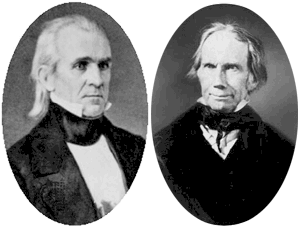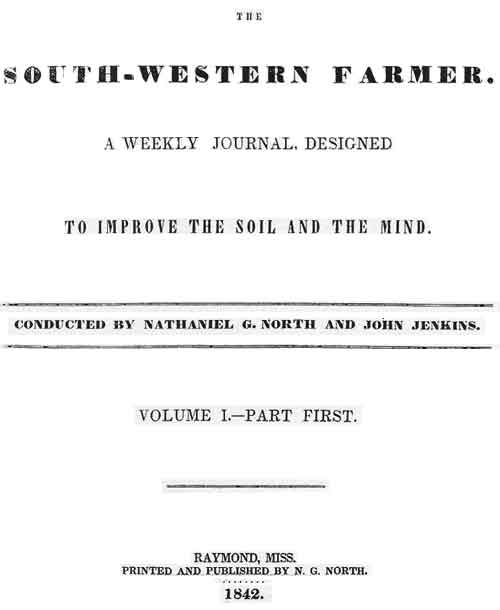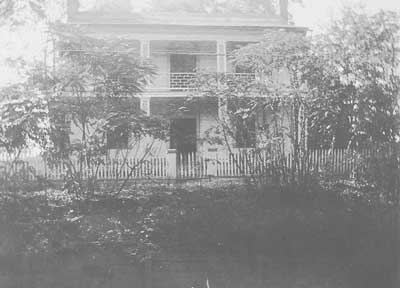"Raymond Years Ago"
By George W. Harper
Journalist - Editor - Owner Of Hinds County Gazette 1845-1883
A Series Published in the Hinds County Gazette, 1878-1879
From the Gillespie Collections edited by Pattie Adams Snowball and Rebecca Blackwell Drake
Home Page
Harper Arrives in Mississippi
Vicksburg & Meridian RR
Businesses in 1844
The Raymond Bar
Early Merchants
1844 Businesses
Seat of Justice
Cotton Industry
Early Churches
Establishment of Schools
John B. Peyton
Raymond Area Homes
Medicinal Resorts & Spas
The Mexican War
Early Churches
Early Schools
Raymond Female Institute
Raymond Military Institute
McNutt-Foote Debate
1844 Presidential Election
Local Elections of 1845
Literary Raymond
Raymond Fires
Old Log Jail
Death of Jos. Stewart
Murder of Benj. Sims
Duel Ends in Death
Raymond & Bolton RR
Harper Elected Mayor
Chaos at Oak Tree Hotel
Great Fire of 1858
Early Area Settlements
-
Amsterdam
-
Yeizer's Store
-
Newtown
-
Meridian Springs
-
Sturgiss Store
-
Dry Grove
-
County Line
Rev. Fisk's Biology Class
Fisk Charged with Fraud
Fleetwood Tragedy
Local Racetracks
Dignitaries Visit Raymond
Winning the Lottery
Fire Company No. 1
"Devoted & Valued Friend"
Tribute to Amos Johnson
Yellow Fever Strikes Raymond
Doctors Treating Victims
Cooper's Well
Mississippi Springs
Newspaper Entrepreneurs
Yankees Sack Gazette Office
Fate of Editorial Giants
Henry Clay Defeated in 1844
Stray Cats in Raymond
"A Remarkable Occurrence"
Blow That Punky Bell to Hell"
Isom Bldgs Destroyed
1851 Gubernatorial Election
Union Ticket Sweeps State
New Raymond Courthouse
Gibbs Building Rebuilt
Hinds Co. Poor House
Schools Struggle
Murder of Addie Owens
War comes to Raymond
The Battle of Raymond
Willie Foote Captured
Make-shift Hospitals
Yankees Occupy Raymond
Raymond Lodge No. 21
Odd-Fellows' Graveyard
Bolls Incarceration
Crimes Blamed on Whisky
Peyton's Willow Tree Prank
Politics in Raymond
Presidential Election 1860
Hinds Co. for Succession
Raymond Fencibles Organized
Churches Reorganize
The Clinton Riot of 1875
Why the Great Uneasiness?
Deaths of Sivley & Thomson
"Kill the Raymond Men"
Harrison Election
Political Gatherings
Event at Dupree's Grove
Presidential Election 1876
Governor Ames Impeached
Great Wrongs Investigated
Fight the Devil with Fire
Reconstruction Era
Harper Ends with Poetic Vision
Part V
The 1844 Presidential Election: Clay and Polk
In 1844, James K. Polk defeated Henry Clay to become the 11th
President of the United States
We were waiting for the evening Raymond hack—there being
but one trip a day between Raymond and the railroad—and spent the 4th of
November, 1844 at Edwards Depot. The presidential election was proceeding
between Clay and Polk, that being the second day, (our elections then were all
held two days.) Mayfield Johnston was the only active man about the polls, and
he was for Clay, but there were no voters there who could be influenced by any
one. Each and all stepped up without molestation and voted their sentiments.
Late in the evening Mayfield asserted that every voter belonging to the precinct
had except one. The box gave a majority for Mr. Clay.
Local Elections of 1845
The first election that we witnessed in Raymond, was the
State and county election of 1845. There was little political feeling, but there
was very spirited and determined contest for the offices of Probate Judge,
between H. G. Johnston and A. R. Johnston; and for Sheriff, between Daniel
Thomas and J. P. Oldham; and for probate Clerk, between W. H. Hampton and Jos.
W. Stewart. The gentlemen here named were unquestionably the most popular men,
personally, in the county, and for capacity for the faithful performance of the
duties attaching to the offices, superior men could not have been found in any
county in the State. Hampton and Stewart were young men—and for natural
affability, and true politeness, and irreproachable morality, and genuine
nobility of nature, they were the equals of any men we have ever known. They
were well matched, but not a whit more so than were the others we named.
The Wigs, who were in a small majority in the county, held
a county convention. It would not nominate for the Judgeship, as that was deemed
a non-political office, and the two Johnstons, both Whigs, were allowed to run
the race alone, as either could distance any man in the county for that
particular office. For Sheriff, everybody outside of the city of Jackson wanted
Daniel Thomas, Democrat, while nearly everybody in Jackson was for Oldham, Whig,
who was then Mayor of that city. The Whig Convention nominated Oldham. For
Clerk, Stewart and Hampton were equally popular with both parties, but Hampton
was nominated by the Whigs, and Stewart, Democrat, ran without a nomination. The
Convention system was then very unpopular in the county, and especially among
the Whigs. After one of the most spirited, but entirely gentlemanly and friendly
canvasses known to the county, the entire Whig nominated ticket, below the
candidates for the Legislature, was defeated—Stewart beating Hampton just EIGHT
votes in a poll of 1700. A. R. Johnston was elected, and so was Daniel
Thomas—but by what majorities we do not now remember.
While the Whigs, as a party, had great personal regard for
and confidence in the Democratic county officers, elected in 1845, they
sympathized deeply with their men who were defeated, and determined to endorse
them fully at another election. And, prompt enough, H. G. Johnston was elected
to the Legislature and Hampton, Probate Clerk, at the next election—and by
overwhelming majorities; and in 1849, and again in 1852, Oldham was elected
Sheriff, in both instances by large majorities. H. G. Johnston died a few years
ago; Oldham died in this town in 1853; Hampton died with yellow fever in 1854,
Stewart’s death will form a paragraph here after.
Raymond Recognized as a Literary Town
Raymond has always had a number of first class writers,
both male and female, of prose and poetry, purely literary and elaborately
political. Many of them have contributed largely not only to the local but to
the distant press, and their writings have been received with uniform
But, with all its talent and ready use of the pen, Raymond
has sent forth to the world but one book, and a copy of that now lies before us.
It is in two Volumes, 717 pages in all, and entitled Texas and the Texans.
It was from the pen of Gen. H. S. Foote, then a member of the Hinds county bar,
and since Governor of the State and United States Senator for six years. The
preface bears this date, “Raymond, Miss., Jan. 5, 1841.” The book was printed at
the Collins house, in Philadelphia, and whether a source of profit or loss to
the author, we have never heard. Gen. Foote then lived in the house now occupied
by J. A. Heard. He moved from Raymond to Jackson in 1842, but when he went to
California in 1854, his family returned to Raymond for a couple of years,
occupying the property now owned by Dr. R. L. Bogle.
The Raymond home of Henry Foote. now extinct, was located on
Homes and Businesses Destroyed by Fire
Raymond has suffered severely by fires since 1844. A
beautiful residence was built by Dr. W. Rossman, in 1847, where Dr. Latimer’s
house now stands. It afterwards passed into the hands of W. Hal Smith, and was
lost by fire about 1855. A very large 2-story residence, belonging to F. A. R.
Wharton, and standing on the lot now occupied by that gentleman, was destroyed
about 1855. A fine 2-story residence, built by Mrs. A. H. Bankston, but then
owned by Amos R. Johnston, standing where Geo. W. Harper’s residence now stands,
was destroyed in 1857. A very handsome residence, standing where Mrs. Belcher’s
house now stands, and which was owned by the late Alex. Belcher, was destroyed
about 1859. A new and elegant, residence, just completed, and owned by Hamilton
Sivley, (near where the steam gin now stands,) was destroyed in 1862. The “great
Raymond fire,” which destroyed twenty-one buildings in the heart of the business
part of the town, occurred Dec. 8, 1858. A block of business houses on the north
side of the public square, was destroyed in 1864. While three business houses
were lost a day or two before the presidential election of 1876.
In 1844 there was rather a strange looking building,
erected at an early period, on the lot just north of the present residence of
Capt. Willis, where there is now a frame office. It was a 2-story building, but
the first story was of brick, while the 2d was frame. Mr. Vanderpool then had a
store in the lower room, while the upper rooms were occupied by the Southwestern
Farmer printing office. E. v.[sic] Seutter subsequently became the owner of the
property, and in his hands it went down in the great conflagration of Dec. 8,
1858.
The building in which the county offices were kept, and, we
believe, the courts held, until the old courthouse was first occupied, continued
to stand until the “big fire,” although it had been somewhat improved. It was a
small frame, with a gallery in front, on Port Gibson street, and on a part of
the lot now occupied by Mr. Gibbs’ store.
Old Log
Jail
The first county jail in Raymond was a log structure—but
had entirely disappeared when we came to the town in1844. It stood in the now
vacant lot between the Methodist church and the residence of Mrs. King. This log
jail, with log flooring, was used from the establishment of the county seat
until the now old stone jail was built.

 commendation and pleasure. The best and most effective political sheet ever
published in the State, was the Snag Boat, a campaign paper issued for
six months in the year 1840, advocating the election of Gen. Harrison. Thousands
upon thousands of them were scattered over the State, and undoubtedly, they did
much in carrying the electoral vote of Mississippi for its candidate. Then there
was the Southwestern Farmer—published from 1841 until 1844—which was, we
think, by all odds, the best agricultural journal ever issued from the press of
the State. It had a large circulation—was edited with marked ability—was printed
in the best style—and its teachings are not yet forgotten by many of our old and
substantial farmers. Then, in 1840, we had for a few months The Comet, a
Democratic paper of rare ability.
commendation and pleasure. The best and most effective political sheet ever
published in the State, was the Snag Boat, a campaign paper issued for
six months in the year 1840, advocating the election of Gen. Harrison. Thousands
upon thousands of them were scattered over the State, and undoubtedly, they did
much in carrying the electoral vote of Mississippi for its candidate. Then there
was the Southwestern Farmer—published from 1841 until 1844—which was, we
think, by all odds, the best agricultural journal ever issued from the press of
the State. It had a large circulation—was edited with marked ability—was printed
in the best style—and its teachings are not yet forgotten by many of our old and
substantial farmers. Then, in 1840, we had for a few months The Comet, a
Democratic paper of rare ability.

Main Street between the Catholic church and the "Little J" railroad.
All photographs and illustrations were edited into the series by Pattie Snowball and Rebecca Drake.
Copyright © 2008 PattieAdams Snowball, James and Rebecca Drake